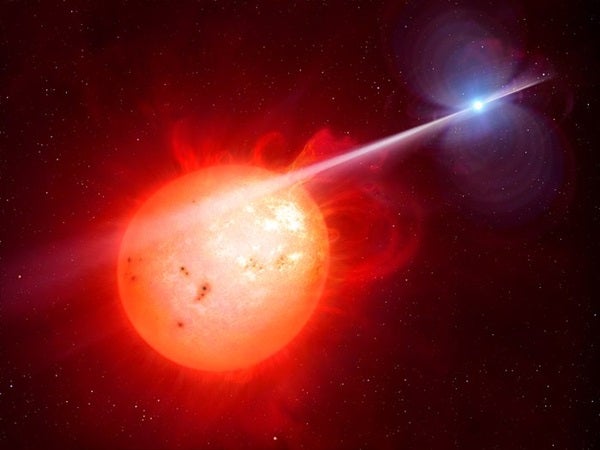Since their discovery by Jocelyn Bell and Antony Hewish in 1967, pulsars have intrigued astronomers as unique and exotic objects. A pulsar is a type of neutron star that emits focused beams of radiation from its poles as it spins. But now, astronomers have discovered a pulsar that’s not a neutron star at all, but a white dwarf. It’s the first white dwarf pulsar ever discovered, after more than 50 years of searching the skies for such an object.
The discovery, published in Nature Astronomy, was made by Professors Tom Marsh and Boris Gänsicke at the University of Warwick’s Astrophysics Group, and Dr. David Buckley of the South African Astronomical Observatory. They found that the binary system AR Scorpii (AR Sco), which sits 380 light-years away in the constellation of Scorpius, contains a white dwarf acting as a pulsar.
Shortly after the first pulsar’s discovery, astronomers sought to understand the type of star responsible for such a signal. The pulsar that Bell and Hewish discovered had a period of slightly over one second (1.3373011 seconds); based on stellar models, this fell just within the rotational limits of a white dwarf. However, much faster pulsars were soon discovered, with periods of milliseconds. Only neutron stars were capable of rotating so quickly, so astronomers settled on these stellar remnants as the common mechanism behind pulsars.
The AR Sco system is comprised of a white dwarf and a red dwarf star, which orbit each other every 3.6 hours at a distance of about 1.4 million kilometers, or three times the distance between Earth and the Moon. As the white dwarf rotates around its axis every two minutes, it blasts its companion with a beam of radiation that excites electrons in the red dwarf’s atmosphere, accelerating these particles to nearly the speed of light. This causes brightness changes that can be observed from Earth at exactly the period of the white dwarf’s rotation.
“AR Sco is like a gigantic dynamo: a magnet, size of the Earth, with a field that is ~10,000 stronger than any field we can produce in a laboratory, and it is rotating every two minutes. This generates an enormous electric current in the companion star, which then produces the variations in the light we detect,” Professor Boris Gänsicke said in the press release announcing their discovery.
What’s in a name?
Neutron stars, which comprise the entire set of pulsars that had been discovered to date, are the dense remnants of a massive star’s core left over after it ends its life in a supernova explosion. It takes a star several times the mass of the Sun to leave such a remnant behind. White dwarfs have a much less violent past — they are the smaller, slightly less dense cores of stars like the Sun, left over once the star’s outer layers have been blown away like a bubble as a planetary nebula. Most white dwarfs are roughly the size of Earth, while most neutron stars are only the size of, say, New York City. Red dwarf stars, thought to be the most common and longest-lived stars, are cool, low-mass Main Sequence stars (in the hydrogen-burning stages of their life) that only contain about 7.5 to 50 percent of the mass of our Sun.
The white dwarf pulsar in AR Sco might be Earth-sized, but it’s 200,000 times as massive as our planet. It also has an electromagnetic field 100 million times the strength of Earth’s, which is responsible for the beams of radiation it emits as a pulsar. “The new data show that AR Sco’s light is highly polarized, showing that the magnetic field controls the emission of the entire system, and a dead ringer for similar behavior seen from the more traditional neutron star pulsars,” said Professor Tom Marsh.
This discovery, and others like it, point to the possibility that white dwarfs aren’t simply the inert remnants of Sun-like stars destined to simply fade away, but continue to play an active role long after the star’s hydrogen-burning phase is complete.










